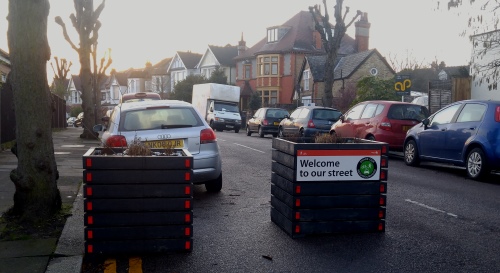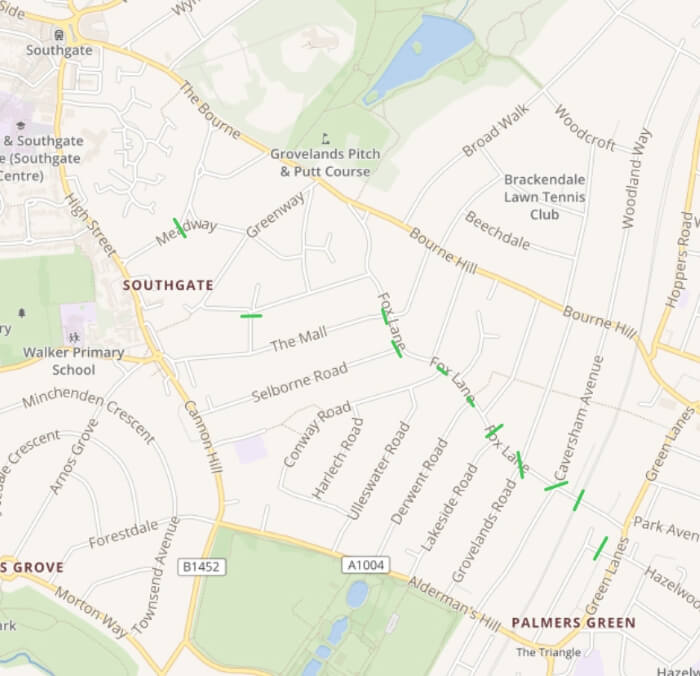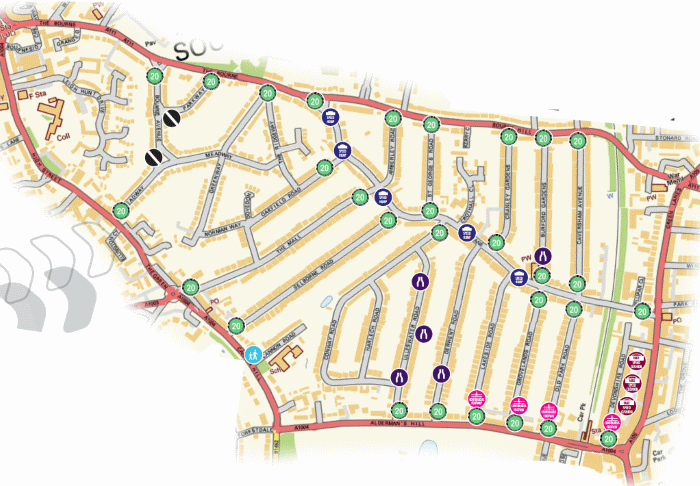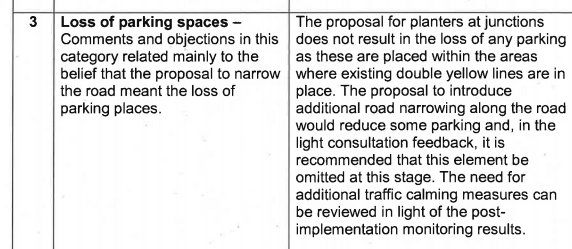
Planters at one end of Old Park Road. Data collected in May showed that traffic along this street had actually increased since the planters were installed.
The news that the trial is being abandoned was published on Monday on the Cycle Enfield website, along with a table comparing summary data collected in November/December 2018 ("baseline data" with the May counts ("interim data"). While in some streets off Fox Lane traffic volumes in the "worst hour" of the day were down somewhat, there were many streets where they had increased, in some cases by a significant amount - for instance, 594 vehicles drove along Old Park Road during its worst hour (8am), a 36 per cent increase.
[If the table below does not display properly and to read the explanation of the speeds shown in the table (the 85th quartile speed), please click here for a pop-out version.]
|
|
Baseline Data |
Interim Monitoring |
Percentage Change |
||||||||
|
Road Name |
Speed data |
Volume |
Speed Data |
Volume |
Speed Data |
Volume |
|||||
|
|
N/E |
S/W |
Total |
Time |
N/E |
S/W |
Total |
Time |
N/E |
S/W |
Total |
|
Amberley Road |
26.2 |
26.3 |
402 |
8am |
23.4 |
24.8 |
397 |
8am |
↓10.7% |
↓5.7% |
↓1.2% |
|
Bourne Avenue |
33.7 |
32.6 |
272 |
8am |
32 |
32.1 |
262 |
8am |
↓5.0% |
↓1.5% |
↓3.7% |
|
Burford Gardens |
30.1 |
28.7 |
106 |
4pm |
29.7 |
28.9 |
106 |
5pm |
↓1.3% |
↑0.7% |
↑0.0% |
|
Cannon Road |
|
|
|
|
18.4 |
18.7 |
62 |
8am |
N/A |
N/A |
N/A |
|
Caversham Avenue |
29 |
31 |
183 |
8am |
30.6 |
32.8 |
228 |
8am |
↑5.5% |
↑5.8% |
↑24.6% |
|
Conway Road |
25.7 |
25.3 |
88 |
8am |
28 |
27.8 |
114 |
8am |
↑8.9% |
↑9.9% |
↑29.5% |
|
Cranley Gardens |
30.4 |
27.9 |
75 |
1pm |
29.6 |
30.9 |
73 |
1pm |
↓2.6% |
↑10.8% |
↓2.7% |
|
Derwent Road |
27.8 |
30.3 |
100 |
12pm |
30.9 |
31.5 |
96 |
11am |
↑11.2% |
↑4.0% |
↓4.0% |
|
Devonshire Road |
30 |
|
117 |
6pm |
27.8 |
|
100 |
7pm |
↓7.3% |
N/A |
↓14.5% |
|
Fox Lane |
28.9 |
24.5 |
548 |
8am |
29 |
30.2 |
594 |
5pm |
↑0.3% |
↑23.3% |
↑8.4% |
|
Greenway |
30.4 |
29 |
154 |
8am |
31.1 |
30.7 |
171 |
8am |
↑2.3% |
↑5.9% |
↑11.0% |
|
Grovelands Road |
29.5 |
29.6 |
140 |
4pm |
29.6 |
29.6 |
172 |
8am |
↑0.3% |
↑0.0% |
↑22.9% |
|
Harlech Road |
27.7 |
27.7 |
66 |
3pm |
27.2 |
27.9 |
44 |
3pm |
↓1.8% |
↑0.7% |
↓33.3% |
|
Lakeside Road |
27.5 |
32.2 |
117 |
12pm |
31.5 |
31.4 |
103 |
5pm |
↑14.5% |
↓2.5% |
↓12.0% |
|
Meadway |
29.7 |
29.6 |
419 |
8am |
31.5 |
30 |
301 |
8am |
↑6.1% |
↑1.4% |
↓28.2% |
|
Oakfield Road |
18.8 |
17.8 |
46 |
12pm |
18.2 |
17.1 |
53 |
8am |
↓3.2% |
↓3.9% |
↑15.2% |
|
Old Park Road |
29.3 |
26.2 |
303 |
8am |
30.2 |
30 |
413 |
8am |
↑3.1% |
↑14.5% |
↑36.3% |
|
Parkway |
26.2 |
24.6 |
59 |
8am |
26.1 |
24.4 |
37 |
8am |
↓0.4% |
↓0.8% |
↓37.3% |
|
Selborne Road |
25.5 |
23.8 |
249 |
8am |
23 |
23.8 |
216 |
8am |
↓9.8% |
↑0.0% |
↓13.3% |
|
St George’s Road |
29.4 |
30 |
153 |
8am |
30.4 |
25.2 |
181 |
8am |
↑3.4% |
↓16.0% |
↑18.3% |
|
The Mall |
20.5 |
20.2 |
368 |
4pm |
21.7 |
21.4 |
419 |
5pm |
↑5.9% |
↑5.9% |
↑13.9% |
|
Ridgeway |
15.9 |
19 |
31 |
9am |
19.7 |
19.9 |
26 |
5pm |
↑23.9% |
↑4.7% |
↓16.1% |
|
Ulleswater Road |
30.3 |
30.5 |
79 |
8am |
43.7 |
26.3 |
106 |
5pm |
↑44.2% |
↓13.8% |
↑34.2 |
The news that the planters are not deterring rat running is unsurprising. They only create a short hold-up for people entering the street, and some residents have surmised that drivers might even go faster once in the street to make up for the "lost" seconds. Certainly, the incidents where planters have been vandalised or moved around suggest that some drivers not only fail to respect the desire of residents for quieter streets, but are actively contemptuous of it.
The council have committed to listening to people's ideas and taking their views into consideration:
We will shortly publish some ideas for an alternative approach for the Fox Lane area using our engagement hub, Let’s Talk Transport which will allow residents to provide their initial thoughts on these ideas (we will collect information to understand whether responses are from residents living in the area or outside). The Council can then review this feedback and consider the next steps. Any implementation that is taken forward will once again be on a trial basis, providing opportunity to re-consider depending upon the evidence of data collected throughout this further trial, along with the views of residents living within the area.
Once the ideas for an alternative approach are published online, all households and businesses within the area will receive a flyer to provide an update and inform them of how they can contribute their feedback and invite them to a community event where they can discuss the ideas with Council Officers.
Local group Better Streets for Enfield are proposing a "low-traffic neighbourhood" scheme and have come up with a draft design. This involves using point closures (also referred to as "filters" because they let through people on foot or on bikes) to stop off one end of a road to prevent cars using it as a through route. Their draft scheme has eleven "filters", which are easily created using bollards (or re-purposed planters). Cars would be able to access every address in the Fox Lane area, but to leave the area they would have to return the way they came. Some streets in the neighbourhood would be accessible from Aldermans Hill or Cannon HIll, others from Bourne Hill or The Bourne.
 The eleven point closures that would create a low-traffic neighbourhood
The eleven point closures that would create a low-traffic neighbourhood
Better Streets say that a "filtered" scheme is ideal for trialling, as bollards or other obstacles can be installed, moved around or removed quickly and cheaply.
If you live in the Fox Lane quieter neighbourhood area, there will be a chance to find out more about what the council intends doing at the next open meeting of Fox Lane & District Residents Association, which will be held in the Burford Hall at 7.45 on Wednesday 12th June. The guest speaker will be Richard Eason from the council team that is running the Quieter Neighbourhoods programme.






